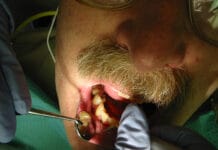The word “tone” has several definitions. You may refer to the tone of your muscles, the tone of a musical instrument, or the tone of a picture. For this article, I am speaking of the tone of the dental professional’s voice. In other words, how the words sound when you speak them out loud within a dental practice.
Individuals throughout the world use the tone of their voice to convey meaning in the words they choose to use. As with fingerprints, we all have a unique voice. The individual voice starts down in your lungs before reaching your vocal folds. The air is moved out of the lungs toward the vocal folds with the coordination of the diaphragm, abdominal muscles, chest muscles, and rib cage. From there, the vocal fold vibration to create voice happens through a sequence of vibratory muscles where air pressure is converted to sound waves.1
Voice and the spoken word result from three components of voice production: voiced sound, resonance, and articulation. Voiced sound is produced by vocal fold vibration.1 Resonance is produced when voiced sound is amplified and modified by the vocal tract resonators (the throat, oral cavity, and nasal passages); the resonators produce a person’s recognizable voice. The vocal tract articulators (the tongue, soft palate, and lips) modify voiced sound to produce articulation. It’s the vocal tract resonators and articulators that modify sound, giving you the distinctive qualities of your voice, and the vocal fold vibration modifies your voice and tone of your voice.1
When we speak to someone in person, such as our co-workers or patients, we have multiple ways to communicate or get our words or point across. You may use body language, specific words, and tone. The human voice can present in many ways. One may choose to whisper or shout as a reaction to how they are feeling at the moment.1 This is how tone enters the picture in our everyday communication.
“Tone of voice is an essential element of communication that often speaks more powerfully than your actual words ever could.”2 Our tone of voice helps us build relationships, influence others, and have an effective chairside manner with our patients. If you are giggling or not speaking your words confidently or proudly when you inform patients about their dental health, they may lose trust and confidence in you as a provider.
The tone of your voice can present in many different forms, including confidence, bold, self-assertive, forceful, probing, optimistic, amusing, entertaining, lighthearted, respectful, humble, or courteous ‒ just to name a few. Not all tones are well-suited for a dental workplace, and it’s important to understand your audience. While a patient is in your chair, you may want to avoid an amused tone of voice when sharing health-related information. However, if you are in the breakroom with your co-workers, that may be a more appropriate place for that particular tone.
“You Need to Brush Better”
Think of this simple statement: “You need to brush better.” Depending on what words you emphasize and the tone you use, that simple statement can be heard in several different ways. Say the statement aloud and switch your tone (your pitch or your volume) on the bolded words below.
Example: You need to brush better
You need to brush better! This could present as forceful.
You need to brush better. This could present as scolding.
You need to brush better. This could present as empathetic.
A Commanding Tone
Have you ever made a mistake, and your doctor or manager spoke to you about it? Were you more upset by the words used, the actions taken, or the tone of voice? More individuals are sensitive to the tone of words used rather than the word itself.3 So why is that? When you review the list of various possible tones of voice, some tones can trigger a reaction from the person you are speaking to.
Consider the last time you were frustrated or aggravated. Maybe someone asked you to help flip an operatory, and you responded sharply with a “Not now!” or “I’m behind!” That individual may have been taken aback, shocked, or saddened by the tone of your voice, not necessarily the words you chose to use. The flip side is that the same request can be asked, and if your mood or tone of voice was different, you might have responded with, “Sorry, I’m running behind. Can you ask Jane?” Or, “You know I’m always willing to help, but I’m swamped today!”
Even while reading this article, you should be able to tell the difference between a terse response or one that uses similar words but has a lighter tone.
The moral of this story is that tone matters. In a dental office, the day begins, and off you go, likely not thinking about your tone and the way that it will affect your patients and your colleagues. Take a few minutes to be mindful of how you will speak with individuals today. Think of using a calm voice with a warm and caring tone. Words matter, so when you choose what you will say, be sure to also choose your tone carefully. It could mean the difference between getting case acceptance, getting your point across, or building better relationships.
Before you leave, check out the Today’s RDH self-study CE courses. All courses are peer-reviewed and non-sponsored to focus solely on high-quality education. Click here now.
Listen to the Today’s RDH Dental Hygiene Podcast Below:
References
- Anatomy and Physiology of Voice Production (n.d.). Voice Foundation. https://voicefoundation.org/health-science/voice-disorders/anatomy-physiology-of-voice-production/understanding-voice-production/
- Improve Your Tone of Voice in Communication. (n.d.). Tony Robbins. https://www.tonyrobbins.com/love-relationships/watching-your-tone/
- Hanson, R. (2019, July 1). Watch Your Tone. Psychology Today. https://www.psychologytoday.com/us/blog/your-wise-brain/201907/watch-your-tone












